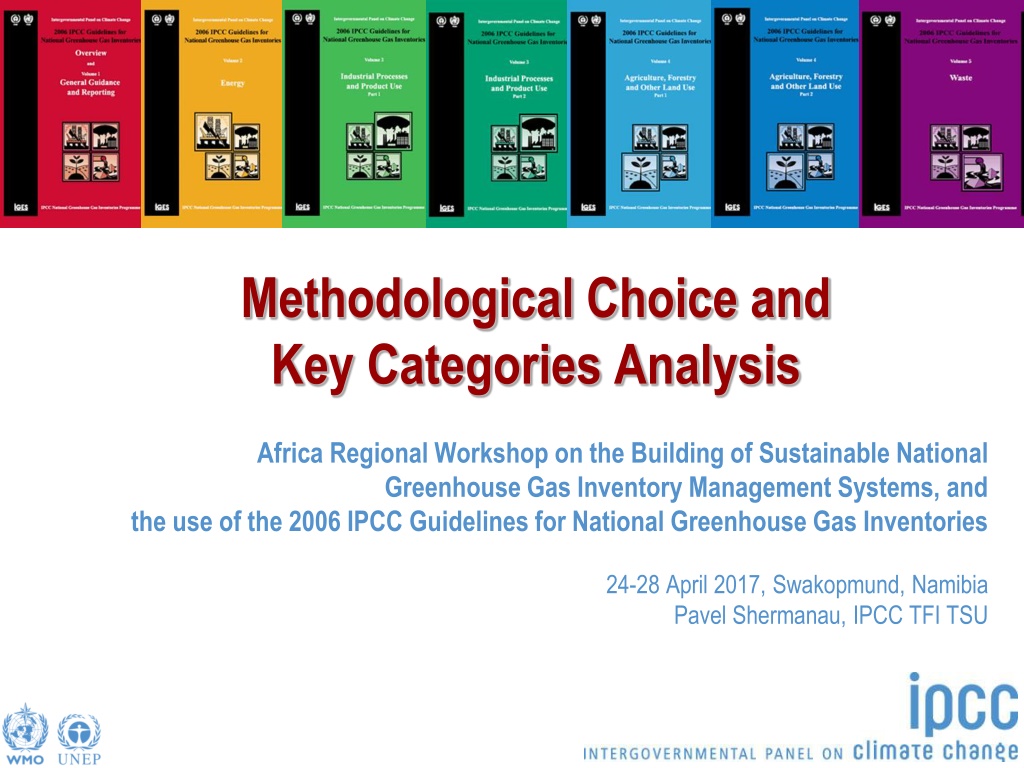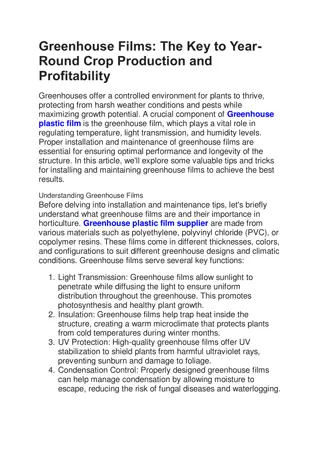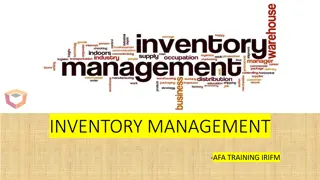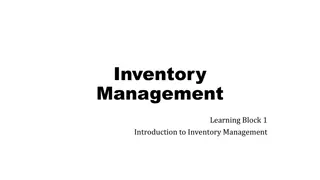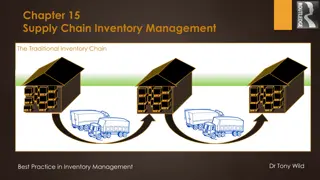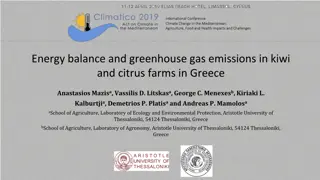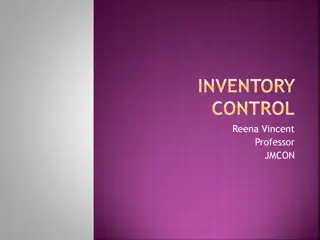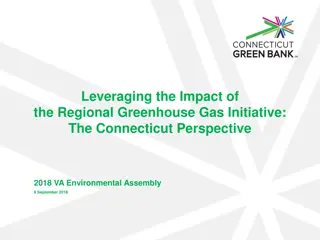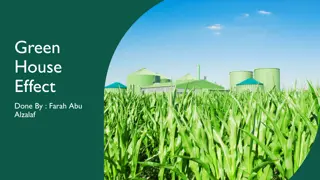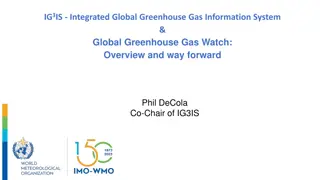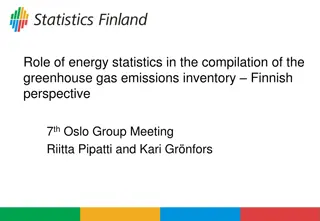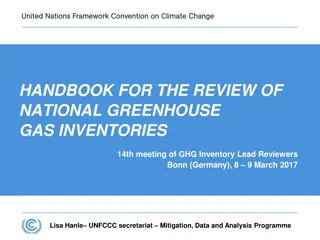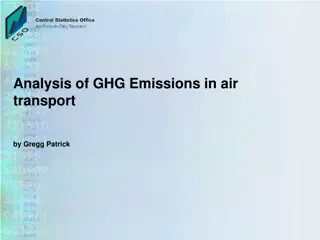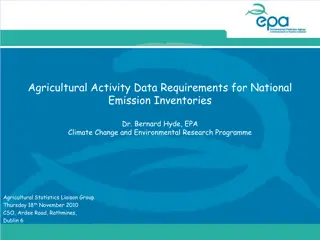Understanding Methodological Choice and Key Categories Analysis in Greenhouse Gas Inventory Management
Methodological choice and key categories analysis play a crucial role in managing uncertainties in greenhouse gas inventories. By prioritizing key categories and applying rigorous methods where necessary, countries can improve the accuracy and reliability of their emissions estimates. Key categories are those with significant impacts on total greenhouse gas inventories, influencing absolute levels, trends, and uncertainties. Prioritizing key categories optimizes resource allocation for data collection and compilation, enhancing overall inventory quality.
- Greenhouse Gas Inventory
- Methodological Choice
- Key Categories Analysis
- Emissions Estimates
- Resource Allocation
Download Presentation

Please find below an Image/Link to download the presentation.
The content on the website is provided AS IS for your information and personal use only. It may not be sold, licensed, or shared on other websites without obtaining consent from the author. Download presentation by click this link. If you encounter any issues during the download, it is possible that the publisher has removed the file from their server.
E N D
Presentation Transcript
Methodological Choice and Key Categories Analysis Africa Regional Workshop on the Building of Sustainable National Greenhouse Gas Inventory Management Systems, and the use of the 2006 IPCC Guidelines for National Greenhouse Gas Inventories 24-28 April 2017, Swakopmund, Namibia Pavel Shermanau, IPCC TFI TSU
Outline 1. Methods: Tier 1, 2, 3 2. Key Category 3. How to define Key Categories: Approach 1, 2 4. Conclusion
Methods: Tier 1, 2, 3 Tiers: A tier represents a level of methodological complexity. Usually three tiers are provided: Tier 1 is the basic method, Tier 2 - intermediate and Tier 3 - most demanding in terms of complexity and data requirements Tiers 2 and 3 are sometimes referred to as higher tier methods and are generally considered to be more accurate
Methodological Choice o Methodological choice for individual source and sink categories is important in managing overall inventory uncertainty (it is lower when emissions and removals are estimated using the most rigorous methods) o However, these methods generally require more extensive resources for data collection, so it may not be feasible to use more rigorous method for every category (therefore it is good practice to identify those categories that have the greatest contribution to overall inventory) o By identifying these key categories in a systematic and objective manner, inventory compilers can prioritise their efforts and improve their overall estimates (it is good practice to use results of key category analysis as a basis for methodological choice to improve inventory quality and to increase confidence in the GHG estimates)
Key Category A key category is one that is prioritised within the national inventory system because its estimate has a significant influence on a country s total inventory of greenhouse gases in terms of: - the absolute level, - the trend, or - the uncertainty in emissions and removals.
Key Category o Key Categories should be the priority for countries during inventory resource allocation for data collection, compilation, quality assurance/quality control and reporting. o In general, more detailed higher tier methods should be selected for key categories
How to Define Key Categories 1. Disaggregate categories to the lowest possible level: to sub-category (e.g., to a fuel type liquid, gaseous, solid) to individual gas (use GWP). 2. Apply two Approaches: Approach 1 Level and Trend Assessment Approach 2 Level/Trend + Uncertainty Assessment
Key categories: Approach 1, 2 Approach 1 Level and Trend Assessment: Key categories - 95% cumulative effect Approach 2 Level/Trend + Uncertainty Assessment: Key categories - 90% cumulative effect Removals: expressed as positive numbers (inclusion/exclusion)
Example of Level Assessment Emission/ Removal Fuel Combustion Activities - Energy Industries: Solid 1A1 CO2 10000 Fuel Combustion Activities - Energy Industries: Liquid 1A1 CO2 200 Fuel Combustion Activities - Manufacturing Industries and Construction: Solid 1A2 CO2 1300 Fuel Combustion Activities - Manufacturing Industries and Construction: Gas 1A2 CO2 123 Fuel Combustion Activities - Transport - Civil Aviation 1A3a CO2 5502 3A2 Manure Management CH4 543 3B1a Forest Land Remaining Forest Land CO2 -2345 3B1b Land Converted to Forest Land CO2 879
Example of Level Assessment Emission/ Removal Absolute Fuel Combustion Activities - Energy Industries: Solid 1A1 CO2 10000 10000 Fuel Combustion Activities - Energy Industries: Liquid 1A1 CO2 200 200 Fuel Combustion Activities - Manufacturing Industries and Construction: Solid 1A2 CO2 1300 1300 Fuel Combustion Activities - Manufacturing Industries and Construction: Gas 1A2 CO2 123 123 Fuel Combustion Activities - Transport - Civil Aviation 1A3a CO2 5502 5502 3A2 Manure Management CH4 543 543 3B1a Forest Land Remaining Forest Land CO2 -2345 2345 3B1b Land Converted to Forest Land CO2 879 879 20892
Example of Level Assessment Emission/ Removal Absolute Level Fuel Combustion Activities - Energy Industries: Solid 1A1 CO2 10000 10000 47.9% Fuel Combustion Activities - Energy Industries: Liquid 1A1 CO2 200 200 1.0% Fuel Combustion Activities - Manufacturing Industries and Construction: Solid 1A2 CO2 1300 1300 6.2% Fuel Combustion Activities - Manufacturing Industries and Construction: Gas 1A2 CO2 123 123 0.6% Fuel Combustion Activities - Transport - Civil Aviation 1A3a CO2 5502 5502 26.3% 3A2 Manure Management CH4 543 543 2.6% 3B1a Forest Land Remaining Forest Land CO2 -2345 2345 11.2% 3B1b Land Converted to Forest Land CO2 879 879 4.2% 20892
Example of Level Assessment Emission/ Removal Absolute Level Fuel Combustion Activities - Energy Industries: Solid 1A1 CO2 10000 10000 47.9% Fuel Combustion Activities - Transport - Civil Aviation 1A3a CO2 5502 5502 26.3% 3B1a Forest Land Remaining Forest Land CO2 -2345 2345 11.2% Fuel Combustion Activities - Manufacturing Industries and Construction: Solid 1A2 CO2 1300 1300 6.2% 3B1b Land Converted to Forest Land CO2 879 879 4.2% 3A2 Manure Management CH4 543 543 2.6% Fuel Combustion Activities - Energy Industries: Liquid Fuel Combustion Activities - Manufacturing Industries and Construction: Gas 1A1 CO2 200 200 1.0% 1A2 CO2 123 123 0.6% 20892
Example of Level Assessment Emission/ Removal Absolute Level Cumulative Fuel Combustion Activities - Energy Industries: Solid 1A1 CO2 10000 10000 47.9% 47.9% Fuel Combustion Activities - Transport - Civil Aviation 1A3a CO2 5502 5502 26.3% 74.2% 3B1a Forest Land Remaining Forest Land CO2 -2345 2345 11.2% 85.4% Fuel Combustion Activities - Manufacturing Industries and Construction: Solid 1A2 CO2 1300 1300 6.2% 91.6% 3B1b Land Converted to Forest Land CO2 879 879 4.2% 95.8% 3A2 Manure Management CH4 543 543 2.6% 98.4% Fuel Combustion Activities - Energy Industries: Liquid Fuel Combustion Activities - Manufacturing Industries and Construction: Gas 1A1 CO2 200 200 1.0% 99.4% 1A2 CO2 123 123 0.6% 100.0% 20892
Approach 1 : Trend The trend assessment identifies categories whose trend is different from the trend of the total inventory, regardless whether category trend is increasing or decreasing, or is a sink or source. Categories whose trend diverges most from the total trend should be identified as key, when this difference is weighted by the level of emissions or removals of the category in the base year.
Category Significance Overall Trend Category Trend
Approach 2: Level/Trend + Uncertainty L and T - the level and trend assessment, U - the uncertainty for category x in year t
Qualitative Analysis Besides a quantitative analysis, there is a qualitative analysis of categories. Some hints: Mitigation techniques and technologies Expected growth No quantitative assessment of uncertainty performed Completeness (incomplete inventory gives incorrect results)
Conclusion Key categories are extremely important: mistakes will lead to significant under-/over- estimates improvements will significantly improve overall inventory quality Higher tiers (Tier 2 and Tier 3) should be used for estimating key categories Resources of national inventory compilers are (in many cases)limited focus on key categories
Thank you for your attention! Any questions?
